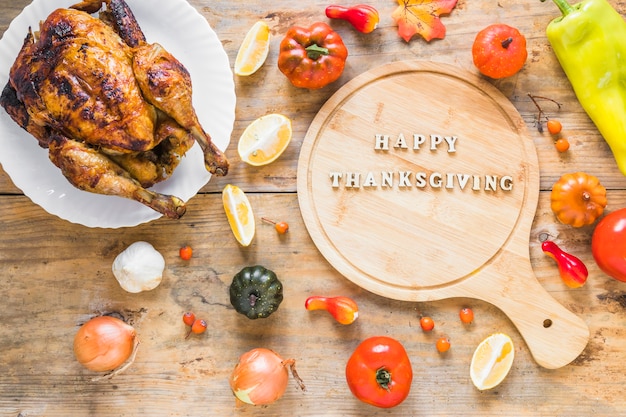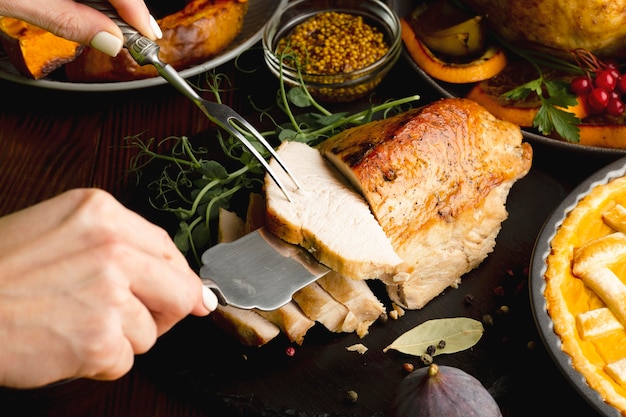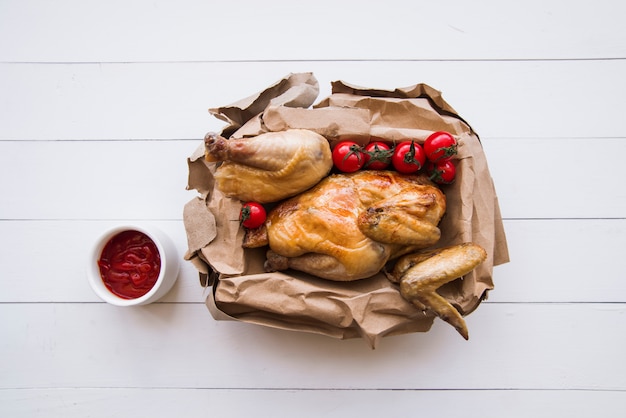Ah, chicken. A staple in countless kitchens, a blank canvas for culinary creativity, and a source of endless comfort. But let's face it: there's nothing quite as disappointing as a dry, overcooked chicken. It's a culinary tragedy, especially when you've poured your heart and soul into creating a delicious meal. That's why I'm here to guide you through the secrets of achieving that perfectly baked chicken – juicy, tender, and bursting with flavour.
This isn't just a recipe; it's a journey. We'll delve into choosing the right bird, understanding the nuances of temperature control, and avoiding those common pitfalls that can leave your chicken dry and unappetizing. I'll share my personal experiences, tips gleaned from years of kitchen adventures (and a few culinary mishaps!), and a sprinkle of wisdom passed down from my granny's trusty recipe book. So, grab a pen, a notepad, and get ready to bake the best chicken of your life.
(Part 1) Choosing the Right Chicken: The Foundation of Flavor

Just like choosing the perfect pair of jeans, selecting the right chicken is the first step towards success. You want a bird that's not just plump and well-shaped, but also possesses that certain "je ne sais quoi" that screams deliciousness. For me, it's all about finding a chicken that's firm to the touch, free of any unpleasant smells or discolouration, and boasts a healthy layer of fat – we're aiming for juicy, not dry, remember?
The whole chicken: A Classic Choice
Whole chickens are my personal favourite. They offer a sense of satisfaction in tackling a larger dish, and the result is a beautiful, evenly roasted bird. When choosing a whole chicken, look for one that's plump and well-shaped, with a nice layer of fat that will keep it juicy during cooking. Don't shy away from a bit of fat – it's a flavour enhancer and moisture magnet!
Remember, the size of the chicken impacts the cooking time. A smaller chicken cooks quicker than a larger one, so adjust your cooking time accordingly. I always err on the side of caution and check the internal temperature with a meat thermometer. You know me, I'm a stickler for safety and perfection.
chicken pieces: Flexibility and Convenience
If you're working with chicken pieces, you can find them already prepped or take the DIY route and do the deboning yourself. I confess, I enjoy the process of deboning a chicken. It's a bit of a sensory experience, and I find it helps me understand the different cuts better. Plus, it gives me a chance to remove any pesky bits of skin or cartilage. But hey, if time is tight, pre-prepped pieces are perfectly acceptable.
Keep in mind that different chicken pieces cook at varying rates. chicken breasts cook faster than chicken legs, for instance. Consider using a baking sheet with a rack to elevate the pieces, ensuring even cooking and crispy skin on all sides.
(Part 2) Prepping the Chicken: The Art of Preparation

Now, onto the prep work. This stage is crucial, a chance to set the stage for a flavour-packed masterpiece. It's where many home cooks go astray, so pay close attention! We're talking about cleaning and seasoning, the building blocks of a truly delectable baked chicken.
Cleaning the Canvas: A Clean Start
First, give your chicken a thorough wash under cold running water. This removes any lingering dirt or bacteria, ensuring a clean and safe meal. Pat it dry with kitchen paper, and you're ready to unleash your seasoning magic.
Seasoning the Chicken: A Symphony of Flavors
I'm a firm believer in simplicity when it comes to seasoning. Salt and pepper are my go-to, a classic combination that enhances the chicken's natural flavour. But feel free to explore the realm of culinary creativity! Herbs like rosemary, thyme, or oregano can add a beautiful depth of flavour. Spices like paprika, cumin, or garlic powder bring a touch of warmth and complexity. Even a bit of citrus zest or a sprinkle of chilli flakes can elevate your chicken to new heights.
My secret? Rub the seasoning all over the chicken, ensuring you get under the skin as well. This creates a flavourful crust while preventing the chicken from drying out. It's a little trick I learned from my granny, and it makes a world of difference.
(Part 3) Roasting the Chicken: The Art of Temperature Control

Alright, let's fire up that oven! roasting time! But before we delve into the temperature, let's talk roasting pan. A roasting pan with a rack is ideal, allowing heat to circulate evenly around the chicken. It's a simple yet essential tool for achieving that perfect roast.
Preparing the Roasting Pan: Setting the Scene
I always give my roasting pan a good scrub with soapy water, then dry it thoroughly. A little bit of oil at the bottom prevents sticking and contributes to a lovely crispy skin. You can even add some vegetables like carrots, onions, and potatoes to the bottom of the pan. They'll roast alongside the chicken, absorbing its delicious juices and adding a touch of sweetness to your meal.
Temperature Control: The Key to Juiciness
Now, for the crucial element: temperature. It's a delicate balancing act, finding the sweet spot where the chicken cooks through without drying out. Here's what I've learned over the years, from countless baking experiments:
- 400°F (200°C): This is my go-to starting temperature. It creates a crispy skin and cooks the chicken relatively quickly. However, with larger chickens, it's wise to lower the temperature to 350°F (175°C) halfway through cooking to prevent over-browning the exterior before the interior is cooked through. It's a subtle adjustment, but it makes a difference in achieving that perfect balance.
- 350°F (175°C): This gentle temperature is ideal for larger chickens or for those seeking a more evenly cooked bird. It takes a bit longer, but it results in a tender and juicy chicken. Patience is key, my friend.
- 325°F (160°C): If you're working with chicken pieces, this lower temperature is perfect for preventing dryness and ensuring even cooking. It's a slower, more gentle approach that yields wonderfully tender results.
(Part 4) Cooking Time: A Dance with Time and Temperature
We've covered temperature, but what about the timing? Well, that depends on the size and weight of your chicken. The packaging usually provides an estimated cooking time, but remember, it's just an estimate. I always recommend checking the internal temperature with a meat thermometer. It's the most accurate way to ensure the chicken is cooked through and safe to eat.
Internal Temperature: The Gold Standard of Doneness
The golden standard for safe chicken cooking is an internal temperature of 165°F (74°C). Check the temperature in multiple places, including the thickest part of the thigh and the breast. Insert the thermometer into the thickest part of the meat, avoiding any bones. It's a simple step, but it ensures peace of mind and a perfectly cooked chicken.
Resting Time: The Secret to Juicy, Flavorful Results
Once the chicken is cooked through, don't rush to carve it! Let it rest for at least 10 minutes before carving. This allows the juices to redistribute throughout the meat, resulting in a juicier and more flavorful chicken. Cover it with foil while it rests, trapping the moisture and allowing the flavours to meld.
Use this resting time to prepare your side dishes. The aroma of a perfectly roasted chicken wafting through your kitchen is a sure sign that a delicious meal is on its way.
(Part 5) Signs of a Perfectly Cooked Chicken: Identifying Success
Now, let's talk about those telltale signs of a perfectly cooked chicken. You'll know it's ready when:
- The juices run clear when you pierce the thickest part of the thigh with a fork. If the juices are still pink, it means the chicken needs to cook a bit longer.
- The chicken is no longer pink inside. This is a good indicator that the chicken is cooked through and safe to eat.
- The skin is crispy and golden brown. This is a sign that the chicken has been roasted at the right temperature for the right amount of time, achieving that perfect caramelized exterior.
If you're ever unsure, it's always better to err on the side of caution and cook the chicken a bit longer. A slightly overcooked chicken is better than an undercooked one, especially when it comes to food safety. Remember, you can always carve off any dry bits, but you can't undo an undercooked chicken.
(Part 6) Variations and Enhancements: Expanding Your Culinary Horizons
Now, let's explore some variations and enhancements for your baked chicken. We're talking about unleashing your culinary creativity, adding your own signature touch to this timeless dish.
Herbs and Spices: A Flavorful Symphony
The world of herbs and spices is your oyster! Experiment with different combinations to create unique flavour profiles. Here are a few ideas to get you started:
- Rosemary and thyme: A classic combination that beautifully complements chicken, offering a fragrant and earthy flavour.
- Garlic and oregano: Adds a touch of Italy to your chicken, bringing a vibrant and aromatic dimension to your dish.
- Paprika and cumin: Introduces a smoky, spicy flavour that adds a touch of warmth and complexity to your chicken.
- Lemon and pepper: A refreshing and tangy combination that adds a bright touch to your chicken.
- Curry powder: A journey to India in your kitchen, with a rich, aromatic flavour that's both exotic and satisfying.
Stuffing the Chicken: Adding Layers of Flavor
Stuffing the chicken is a fun way to add another dimension of flavour. Use a mixture of herbs, bread crumbs, or even vegetables. Just remember to cook the stuffing separately if you're using raw ingredients. This ensures it's cooked through and safe to eat. For extra flavour, consider using a homemade breadcrumb mix or incorporating roasted vegetables for added depth.
Glazing the Chicken: Creating a Shiny, Delicious Finish
Glazing your chicken is a fantastic way to add a touch of sweetness and create a beautiful, glossy finish. Use honey, maple syrup, or a simple mixture of butter and herbs. The glaze caramelizes in the oven, creating a delicious, sticky coating that elevates the taste and appearance of your chicken.
My advice? Apply the glaze during the last 30 minutes of cooking. This gives it enough time to caramelize without burning. It's a simple trick that yields beautiful results.
(Part 7) Avoiding Common Mistakes: Learning from Experience
We all make mistakes in the kitchen. But with a little knowledge and practice, you can avoid some common errors and ensure a truly delicious outcome.
Don't Overcrowd the Roasting Pan: Giving the Chicken Space
Give your chicken enough room to breathe in the roasting pan. Overcrowding can lead to uneven cooking and a steamed, rather than roasted, result. Remember, circulation is key for a crispy skin and perfectly cooked meat.
Don't Overcook the Chicken: Tenderness Over Toughness
Overcooked chicken is dry and flavourless. We've already talked about checking the internal temperature with a meat thermometer, but it's worth repeating. Don't be afraid to pull the chicken out a few minutes early if you're unsure. It's better to have a slightly undercooked chicken than a dry, tough one. It's a delicate balance, but with practice, you'll master the art of timing.
Don't Forget to Rest the Chicken: Locking in Flavor and Moisture
Resting the chicken after cooking is crucial for maximizing juiciness. We've already discussed this, but it's a key step that's often overlooked. Allow it to rest for at least 10 minutes before carving, allowing the juices to redistribute throughout the meat. This simple step makes a significant difference in the overall tenderness and flavour of your chicken.
(Part 8) Serving and Enjoying Your perfect chicken: The Culinary Finale
The moment has arrived! Your perfectly baked chicken is ready to be enjoyed. Serve it with your favourite side dishes – mashed potatoes, roasted vegetables, stuffing, gravy, or a simple green salad. The possibilities are endless, allowing you to create a meal that truly reflects your culinary style.
Carving the Chicken: Presentation is Key
I love the ritual of carving the chicken at the table, but you can do it beforehand if you prefer. Use a sharp knife and carefully remove the legs and thighs from the body. Then, slice the breast into thin pieces. A little bit of presentation goes a long way, so take your time and create a beautiful, tempting platter.
Leftover Magic: Transforming Your Chicken
Leftover chicken is a culinary treasure! Use it to create delicious sandwiches, salads, or soups. A simple chicken salad is a quick and easy lunch, while a hearty chicken noodle soup is perfect for a cozy evening meal. You can also use leftover chicken to make a delicious chicken pie or curry, adding a new dimension to your culinary repertoire.
(Part 9) FAQs: Addressing Your Chicken Concerns
Let's tackle some frequently asked questions, addressing those burning chicken concerns that often arise in the kitchen.
1. Can I use frozen chicken for roasting?
Absolutely! You can use frozen chicken for roasting. Just make sure to thaw it completely before cooking. You can thaw it in the refrigerator overnight or in a cold water bath. If you're using a cold water bath, change the water every 30 minutes to ensure it stays cold and the chicken thaws evenly.
2. How long should I roast a whole chicken for?
The cooking time for a whole chicken varies depending on its size and weight. A general rule of thumb is to allow 20 minutes per pound at 350°F (175°C). However, it's always best to check the internal temperature with a meat thermometer to ensure the chicken is cooked through. Remember, every oven is different, and it's always best to err on the side of caution when it comes to cooking time.
3. What are some good side dishes to serve with roast chicken?
The world of side dishes is your playground! Roast chicken pairs beautifully with classic sides like mashed potatoes, roasted vegetables, stuffing, gravy, and green salad. But don't be afraid to get creative! Consider serving it with quinoa salad, roasted brussels sprouts, or even a sweet potato casserole. It's all about finding a combination that suits your taste and your meal.
4. Can I bake chicken with the skin on or off?
You can bake chicken with the skin on or off, but I prefer to bake it with the skin on. It helps to create a crispy skin and keeps the chicken moist. If you're concerned about the fat content, you can remove the skin after the chicken is cooked. It's all about personal preference, and both methods can yield delicious results.
5. How can I tell if my chicken is overcooked?
Overcooked chicken will be dry and tough. The juices will be clear, and the meat will be pale. You can also check the internal temperature. Overcooked chicken will have an internal temperature of over 165°F (74°C). If you suspect your chicken is overcooked, it's best to slice it open and check the internal temperature. You can always try to salvage a slightly overcooked chicken by adding a bit of moisture, such as a gravy or sauce, but it's always best to aim for a perfectly cooked bird.
There you have it, my friends! A comprehensive guide to achieving that perfect baked chicken. Now go forth and conquer your kitchen. May your chickens be juicy, tender, and bursting with flavour!
Everyone is watching

Perfect Rice Every Time: The Ultimate Guide to Cooking Rice
Cooking TipsAs a self-proclaimed foodie, I've always been a bit obsessed with rice. It's the foundation of countless cuisi...

Prime Rib Roast Cooking Time Chart: Per Pound Guide
Cooking TipsPrime rib roast. Just the name conjures images of lavish dinners, crackling fires, and hearty laughter. It’s ...

The Ultimate Guide to Cooking Asparagus: Tips, Techniques, and Recipes
Cooking TipsAsparagus. The mere mention of this spring delicacy conjures up images of vibrant green spears, crisp and burs...

Ultimate Guide to Cooking the Perfect Thanksgiving Turkey
Cooking TipsThanksgiving. Just the word conjures up images of overflowing tables laden with delicious food, the scent of r...

How Long to Bake Potatoes in the Oven (Perfect Every Time)
Cooking TipsBaked potatoes are a staple in my kitchen. They're incredibly versatile, delicious, and surprisingly easy to m...
